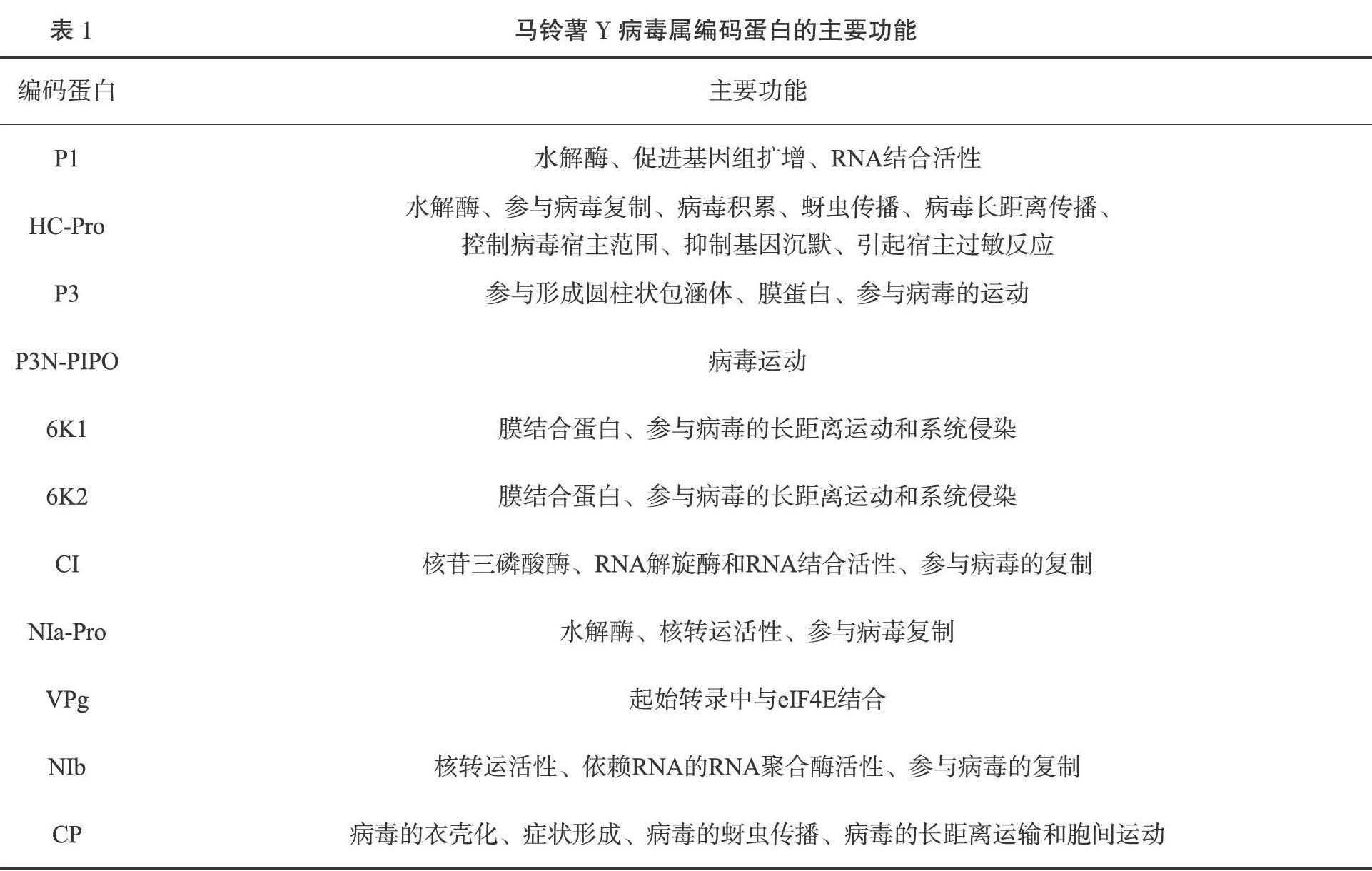马铃薯Y病毒属病毒的致病机理及植物抗性机制研究进展
2021-05-31张莉娟林垠孚吴凤李今朝农耀京
张莉娟 林垠孚 吴凤 李今朝 农耀京

摘 要:马铃薯Y病毒属病毒是世界范围内影响范围广、危害严重并造成重大经济损失的病毒属之一,侵染的物种主要有茄科、豆科、藜科等农作物和经济作物。本研究综述了近年来关于马铃薯Y病毒属病毒的致病机理和植物对抗此类病毒的抗性机制,为更好的理解和防控马铃薯Y病毒属病毒提供理论参考。
关键词:马铃薯Y病毒属 致病机理 植物抗性
中图分类号:Q93 文献标识码:A
Research Progress on Pathogenesis of Potyvirus and Plant Resistance Mechanism
ZHANG Lijuan1, LIN Yinfu2, WU Feng1, LI Jinzhao1, NONG Yaojing1
(1Guangxi Subtropical Crops Research Institute, Nanning, Guangxi 530001, China;
2College of Life Science and Technology,Guangxi University,Nanning,
Guangxi 530005, China)
Abstract: Potyvirus is one of the most widely distributed viruses in the world, causing serious damage and huge economic losses. The main species infected by Potyvirus are Solanaceae, Leguminosae and Chenopodiacea. This article reviews the pathogenesis of Potyvirus and the plant resistance mechanism to Potyvirus in recent years, so as to provide theoretical reference for better understanding, prevention and control of Potyvirus.
Key words: Potyvirus; pathogenesis; plant resistance
马铃薯Y病毒属是迄今为止最大的植物RNA病毒属,国际植物病毒分类委员会(ICTV)在2017年公布的数据显示,共发现160个马铃薯Y病毒属种类病毒。归类为马铃薯Y病毒属的大部分病毒是根据它们的生物学特性和病毒粒子形态等,比如血清学特性和对指示植物的反应。该属病毒含有的典型病毒种有:马铃薯Y病毒(potato virus Y,PVY)、芜菁花叶病毒(turnip mosaic virus,TuMV)、大豆花叶病毒(soybean mosaic virus,SMV)、西葫芦黄花叶病毒(zucchini yellow mosaic virus,ZYMV)、甘蔗花叶病毒(sugarcane mosaic virus,SCMV)、李痘病毒(plum pox virus,PPV)等。马铃薯Y病毒属病毒因其分子特性,易变异,每个病毒种包含多个株系。如PVY被划分为非重组株系N、O、C和重组株系NTN、N-Wi、N:O、NTN-NW[1];Ohshima将TuMV划分为Basal-B、World-B、Basal-BR和Asian-BR四个类群[2];高波等将SCMV划分为Ⅰ、Ⅱ、Ⅲ、Ⅳ四个组[3];南京农业大学国家大豆改良中心将我国的SMV分离物划分为SC1-22共22个株系[4];PPV主要包含D、M、C、W、Rec、EA、T共7个株系,其中M和D是主要流行株系[5, 6] 。马铃薯Y病毒属病毒基因组全长约10kb,属于正义单链RNA病毒,含有两个开放阅读框。其中大的开放阅读框编码一个多聚蛋白,后由自身编码的蛋白酶将多聚蛋白裂解为10个成熟的蛋白质:第一蛋白(P1)、辅助成分蛋白酶(HC-Pro)、第三蛋白(P3)、第一个6K蛋白(6K1)、圆柱状内含体蛋白(CI)、第二个6K蛋白(6K2)、基因组关联病毒蛋白(VPg),核内含体蛋白a(NIa),核内含体蛋白b(NIb),外壳蛋白(CP)。另一个小的开放阅读框编码三个蛋白:P1、HC-Pro以及P3N-PIPO融合蛋白。三個蛋白酶参与了多聚蛋白的裂解:P1和HC-Pro之间的位点由第一蛋白酶在二肽Tyr304-Ser305处裂解[7],HC-Pro和P3之间的位点由辅助成分-蛋白酶在二肽Gly763-Gly764处裂解[8],余下的位点由核内含体蛋白酶在保守序列Glu-Xaa-Xaa-Tyr-Xaa- Gln-Ser/ Gly 中的Gln后裂解[9]。同时5'端共价结合VPg蛋白,3'UTR有一个polyA尾。
1 马铃薯Y病毒属病毒的致病机理
病毒蛋白相互协作完成病毒的侵染、复制、运动、传播等生命周期过程,从而完成对宿主的侵染。
1.1 第一蛋白
P1是马铃薯Y病毒属的第一个蛋白,在PVY中是最小的保守蛋白,大小在30 kDa到63 kDa之间[10, 11]。P1作为蛋白水解酶,其C末端的水解区域类似胰凝乳蛋白酶样的丝氨酸蛋白酶,His-214、Asp-223和Ser-256组成催化的三体结构(同样重要的还有Asp288)[7]。在烟草蚀纹病毒(tobacco etch potyvirus,TEV)中,验证了P1具有促进基因组扩增的功能[11],但在病毒运动中几乎不发挥作用。除此之外,在tobacco vein mottling virus(TVMV)中证明了P1体外结合RNA的活性,且更偏向于结合ssRNA[12]。
1.8 外壳蛋白
CP是病毒RNA编码的最后一个蛋白,可参与病毒的衣壳化、症状形成[42]、病毒的蚜虫传播[43]、病毒的长距离和胞间运动等[44]。PVY的CP与HC互作对于PVY属病毒的传播是重要的,两者的互作跟CP N端的DAG基序(DTVDAGK)有关,进一步证明了CP上的H256和HC-Pro上的R455,以及DAG基序上的G12对CP和HC-Pro的相互作用至关重要[45]。然而,还不清楚一个膜分隔的6K2复合物是如何通过HC-Pro和CP与PD相互作用的,病毒是否以包膜病毒粒子的形式移动还有待观察[46]。
2 植物抗病毒机制
2.1 显性基因介导的显性抗性
植物本身具有一些抗性因子抵抗病毒的侵染,其中R基因介导的显性抗性是其中一种。大多数R基因编码核苷酸结合和亮氨酸丰富的结构域(NB-LRR)蛋白,在植物中数量很多,拟南芥中已经鉴定出159个,在茄科植物中的数量是拟南芥的两倍多[47, 48]。根据N端的结构域,NB-LRR基因分为两个类型:Toll/interleukin-1 receptor (TIR)–NB-LRRs (TNLs)和coiled-coil (CC)-NB-LRRs (CNLs),TIR和CC区域参与了防御信号激活的同源二聚体的形成。NB-LRR的中心区域,又称为NB-ARC,NB-ARC结构域作为核苷酸结合囊,水解ATP,诱导R蛋白构象变化。C端的LRR主要作用于蛋白互作时识别不同的序列,影响蛋白的识别特异性。NB-LRR蛋白通过LRR与中间区域的互作维持R蛋白的“关闭”状态,避免R蛋白产生自身免疫,在病原体入侵时,R蛋白直接或间接地与效应器互作使其成为“开启”状态。这种效应器也被称为Avr因子,一般是无毒性的病毒蛋白,由R基因编码的蛋白质与Avr效应蛋白相互作用,诱导一种快速而强烈的抗性反应,称为效应触发免疫(ETI),一般与超敏反应(HR)相关。R基因介导的病毒抗性也是基因—基因抗性。R基因与Avr识别的机制目前有三种:(1)“受体—配体”结合的直接相互作用;(2)R蛋白通过寄主辅助蛋白与Avr蛋白结合的间接相互作用;(3)Avr进入寄主细胞核结合R基因启动子的调控元件,激活R基因的表达的转录调控方式[49]。
马铃薯中对抗Potyvirus的抗性基因类型有两种,一种是Ry基因赋予的极端抗性(extreme resistance,ER),另一种是Ny基因赋予的超敏抗性(hypersensitive resistance,HR),也是区别不同PVY株系的症状表现基因,大部分的抗性基因被定位在马铃薯基因组IV, IX, XI 和XII染色体上。已经被鉴定出来的马铃薯上抗PVY的Ryadg、Rysto、Rychc基因,抗马铃薯A病毒 (Potato virus A,PVA) 的Rx1、Rx2基因[50]。辣椒中抗PVY的显性抗性基因鉴定出来的有Pvr4、Pvr7和Pvr9,Pvr4和Pvr7是连锁基因,来自辣椒品种CM334的Pvr4对广泛的马铃薯Y病毒属的病毒具有抗性,位于辣椒的10号染色体上[51]。
2.2 隐性基因介导的抗性
植物中也存在大量的隐性抗性基因,其中很大一部分是编码真核生物翻译起始因子4E或者4G家族。辣椒中的隐形抗性基因pvr1、pvr2、pvr3、pvr5、pvr6、pvr8,分别对不同的PVY株系有抗性[51]。已探明马铃薯Y病毒属病毒编码的多个蛋白与翻译起始因子蛋白互作,例如Vpg(前文已提到)、HC-Pro,PVA中的Vpg含有的基序Tyr-X-X-X-X-Leu-phi (YXXXLΦ)绑定eIF(iso)4E,HC-Pro上也有类似的4E结合基序,都可以与4E(eIF4E)和eIF(iso)4E互作[39]。真核细胞中,eIF4E/(iso)4E结合到mRNA的5端帽子结构组成翻译起始复合体eIF4F/(iso)4F,复合体同时含有支架蛋白eIF4G/(iso)4G、解旋酶eIF4A/(iso)4A、poly A尾结合蛋白(poly(A)-binding protein,PABP),从而起始翻译。
2.3 宿主蛋白参与病毒侵染
病毒侵染单靠病毒蛋白远远不够,侵染完成是病毒蛋白与宿主蛋白相互作用的结果,实验表明大量的宿主蛋白参与了病毒的生命周期循环。当病毒PVY侵染烟草宿主细胞后,宿主细胞内的磷酸葡萄糖酸脱氢酶、磷酸核糖异构酶、磷酸核糖焦磷酸激酶参与了病毒RNA的生物合成[52]。PVA的病毒蛋白HC-Pro能与微管结合蛋白HIP1和HIP2互作,引导病毒的运动和积累,HC-Pro上氨基酸残基323-352控制这一过程[53]。侯含等证明了PVY侵染烟草能导致烟草细胞内的ROS的升高,进而引起细胞自噬和过氧化物酶体自噬,从而调节病毒对宿主细胞的影响[54]。细胞自噬是植物体内组织稳态和发育关键的进化保守过程,在病毒侵染宿主细胞后,细胞自噬蛋白靶向病毒蛋白进行溶酶体降解,同时病毒在进化过程中会编码一些毒力蛋白对抗自噬的作用,在动物病毒中细胞自噬研究的比较多,但在植物上相对较少,目前在马铃薯Y病毒属病毒中这一过程涉及的机制还需要大量研究去探索。MAPK参与包括防御激素的生物合成/信号传导和ROS的生成等多种防御反应的信号传导。在一些病毒侵染宿主引起的严重反应如系统性坏死,宿主细胞内的撕裂原活化蛋白激酶(Mitogen-activated protein kinase,MAPK)基因(WIPK和SIPK)和撕裂原活化蛋白激酶激酶(MAPK kinase,MAPKK)基因(MKK1和MEK1)对细胞死亡是正向调节因子[55],但并不抑制细胞坏死诱发的病毒的积累。
3 植物抗馬铃薯Y病毒属病毒的研究
3.1 转基因抗性
通过转病毒基因增强植物的病毒抗性的研究,发现了植物另一种抗病毒机制:RNA沉默介导的病毒抗性,即植物对外源的核酸具有识别和降解功能。
利用siRNA介導的病毒抗性运用比较多[56],对PVY中的 P1、HC-Pro、Vpg、P3、CI、NIa、NIb、CP进行基因转化,在转基因植株体内都能检测到病毒抗性,但抗性随着基因的不同而效率不同[57]。通过干扰对病毒生命活动影响较大的基因(如CI和CP),可能会带给植物更大的抗性。另外干扰片段的选择也会影响转基因的病毒抗性,对比多病毒序列从而选择更加保守的基因片段进行干扰,效率更高,这在生产上也具有重大意义[58]。干扰片段的长度不宜过长也不宜过短,另每个基因干扰的位置不同也会带来不同的抗性效率,需要大量实验去探索合适的干扰位点[59]。siRNA介导的病毒抗性除了自身的优点外,也可能会带来不同病毒的重组、靶标的错配等缺陷,人工miRNA (amiRNA)的应用将更有发展前景。RNA介导的植物对病毒的抗性也有很多局限性,例如转基因抗病植株还局限在试验阶段;RNA病毒易变异。病毒病当前没有十分有效的防治手段,转基因抗病毒还是具有重要的应用研究价值。
3.2 宿主基因沉默
除了病毒基因介导的植物病毒抗性外,利用宿主基因的沉默也能达到抑制病毒的作用。宿主上有多个参与病毒生命周期的宿主蛋白,热激蛋白70(heat shock protein 70,Hsp70)参与病毒的复制过程,沉默烟草Hsc70-2基因明显抑制烟草中PVY的表达量[60]。应用转录激活样效应因子核酸酶(Transcription Activator-Like Effector Nucleases,TALENs)技术定向编辑敲除真核翻译起始因子eIF4E-6,获得杂合突变型T0代株系[61]。因宿主基因往往赋予植物一些特定功能,需要谨慎筛选既对植物生长影响小又对病毒抗性强的宿主基因,需要进一步探索合适基因。
4 讨论
马铃薯Y病毒属病毒是迄今为止发现的危害植物的最大的植物RNA病毒属,可造成宿主植物的减产、减质,本文综述了马铃薯Y病毒属病毒编码的蛋白的功能、植物参与对抗病毒侵染的抗性因子及植物在生物胁迫时诱导产生的应激反应、利用基因工程增强植物的病毒抗性等。目前对马铃薯Y病毒属病毒的致病机理研究有了一定的进展,但在一些方面还未阐明清楚。病毒侵染植物细胞引起ROS的升高从而调控细胞自噬,但并不抑制病毒在细胞内的积累,ROS如何调控细胞自噬,病毒又是通过什么机制对抗细胞自噬对自身的清除,这需要大量的工作去探索。针对马铃薯Y病毒属病毒,植物隐性抗性基因发挥了重要的病毒抗性作用,但目前鉴定和研究的多集中于翻译起始因子,是否存在更多其他的基因。病毒完成侵染需要与寄主蛋白互作,借助病毒-寄主互作,不同的病毒感染造成的病害症状往往存在差异,目前互作引起的寄主变化主要集中干扰信号通路、影响miRNA及其靶基因的表达、介导病毒的生命活动等[62],使寄主症状呈现不同的表现。马铃薯Y病毒属病毒属于单链RNA病毒,易变异,病毒蛋白与宿主蛋白互作的代谢途径还不完整,进一步完善代谢途径也为利用宿主基因沉默抑制病毒提供更多可操作的基因选择。
参考文献
[1] Hu X, Karasev A V, Brown C J, et al. Sequence characteristics of potato virus Y recombinants[J]. The Journal of General Virology, 2009, 90(12): 3033-3041.
[2] Anon. Patterns of recombination in turnip mosaic virus genomic sequences indicate hotspots of recombination[J]. Journal of General Virology, 2007, 88(pt1): 298-315.
[3] Gao B , Cui X W, Li X D , et al. Complete genomic sequence analysis of a highly virulent isolate revealed a novel strain of sugarcane mosaic virus[J]. Virus Genes, 2011, 43(3): 390-397.
[4] 杨永庆,智海剑,张孟臣. 黄淮海抗大豆花叶病毒(SMV)育种现状与展望[J].华北农学报,2014,29(1):103-108.
[5] Serce C U, Candresse T, Svanella-Dumas L, et al. Further characterization of a new recombinant group of Plum pox virus isolates, PPV-T, found in orchards in the Ankara province of Turkey[J]. Virus Research, 2009, 142(1-2): 121-126.
[6] 林司曦,丁晓磊,叶建仁,等.李痘病毒在中国的入侵风险评[J].南京林业大学学报(自然科学版),2016,40(6):187-192.
[7] Verchot J, Herndon K L, Carrington J C. Mutational analysis of the tobacco etch potyviral 35-kDa proteinase: Identification of essential residues and requirements for autoproteolysis[J]. Virology, 1992, 190(1): 298-306.
[8] Carrington J C, Cary S M, Parks T D, et al. A second proteinase encoded by a plant potyvirus genome[J]. The EMBO Journal, 1989, 8(2): 365-370.
[9] Carrington J C, Cary S M, Dougherty W G. Mutational analysis of tobacco etch virus polyprotein processing: cis and trans proteolytic activities of polyproteins containing the 49-kilodalton proteinase[J]. Journal of Virology, 1988, 62(7): 2313-2320.
[10] Vance V B, Moore D, Turpen T H, et al. The complete nucleotide sequence of pepper mottle virus genomic RNA: Comparison of the encoded polyprotein with those of other sequenced potyviruses[J]. Virology, 1992, 191(1): 19-30.
[11] Verchot J, Carrington J C. Evidence that the potyvirus P1 proteinase functions in trans as an accessory factor for genome amplification[J]. Journal of Virology, 1995, 69(6): 3668-3674.
[12] Brantley J D, Hunt A G. The N-terminal protein of the polyprotein encoded by the potyvirus tobacco vein mottling virus is an RNA-binding protein[J]. The Journal of General Virology,1993,74(6): 1157- 1162.
[13] Haikonen T, Rajamki M L, Tian Y P, et al. Mutation of a short variable region in HCpro protein of Potato virus A affects interactions with a microtubule-associated protein and induces necrotic responses in tobacco[J]. Molecular Plant Microbe Interactions, 2013, 26(7): 721-733.
[14] Seo J Y, Kang S H, Seo B Y, et al. Mutational analysis of interaction between coat protein and helper component-proteinase of Soybean mosaic virus involved in aphid transmission[J]. Molecular Plant Pathology, 2010, 11(2): 265-276.
[15] Saenz P, Salvador B, Simon-Mateo C, et al. Host-specific involvement of the HC protein in the long-distance movement of Potyviruses[J]. Journal of Virology, 2002, 76(4): 1922-1931.
[16] Tian Y P, Valkonen J P. Genetic determinants of Potato virus Y required to overcome or trigger hypersensitive resistance to PVY strain group O controlled by the gene Ny in potato[J]. Molecular Plant Microbe Interactions,2013,26(3): 297-305.
[17] Peng Y H, Kadoury D, Gal-On a, et al. Mutations in the HC-Pro gene of zucchini yellow mosaic potyvirus: effects on aphid transmission and binding to purified virions[J]. The Journal of general virology, 1998, 79(4): 897-904.
[18] Kasschau K D, Cronin S, Carrington J C.Genome amplification and long-distance movement functions associated with the central domain of Tobacco Etch Potyvirus helper component–proteinase[J]. Virology, 1997, 228(2): 251-262.
[19] Tribodet M, Glais L, Kerlan C, et al. Characterization of Potato virus Y (PVY) molecular determinants involved in the vein necrosis symptom induced by PVYN isolates in infected Nicotiana tabacum cv. Xanthi[J]. Journal of General Virology, 2005, 86(7): 2101-2105.
[20] Varrelmann M, Maiss E, Pilot R, et al. Use of pentapeptide-insertion scanning mutagenesis for functional mapping of the plum pox virus helper component proteinase suppressor of gene silencing[J]. Journal of General Virology,2007,88(pt3): 1005- 1015.
[21] Saenz P, Salvador B, Simon-Mateo C, et al. Host-specific involvement of the HC protein in the long distance movement of Potyviruses[J]. Journal of Virology, 2002, 76(4):1922-1931.
[22] Xiaoyan C, Hoda Y, Guanwei W, et al. The C-terminal region of the Turnip mosaic virus P3 protein is essential for viral infection via targeting P3 to the viral replication complex[J]. Virology, 2017, 510: 147-155.
[23] Sáenz P, Cervera M T, Dallot S, et al. Identification of a pathogenicity determinant of Plum pox virus in the sequence encoding the C-terminal region of protein P3+6K1[J]. Journal of General Virology, 2000, 81( 3): 557-566.
[24] Cui X, Yaghmaiean H, Wu G, et al. The C-terminal region of the Turnip mosaic virus P3 protein is essential for viral infection via targeting P3 to the viral replication complex[J]. Virology, 2017, 510: 147-155.
[25] Spetz C, Valkonen J P T. Potyviral 6K2 protein long-distance movement and symptom-induction functions are independent and host-specific[J]. Molecular plant-microbe interactions : MPMI, 2004, 17(5): 502-510.
[26] Grangeon R, Agbeci M, Chen J, et al. Impact on the endoplasmic reticulum and golgi apparatus of Turnip mosaic virus infection[J]. Journal of Virology, 2012, 86(17): 9255-9265.
[27] Taiyun W, Changwei Z, Xilin H, et al. The SNARE protein Syp71 is essential for turnip mosaic virus infection by mediating fusion of virus-induced vesicles with chloroplasts[J]. Plos Pathogens, 2013, 9(5): e1003378.
[28] Romain G, Jiang J, Wan J, et al. 6K2-induced vesicles can move cell to cell during turnip mosaic virus infection[J]. Frontiers in Microbiology, 4: 351.
[29] Juan W, Garcia C D, Huanquan Z, et al. Turnip mosaic virus moves systemically through both phloem and xylem as membrane-associated complexes[J]. Plant Physiology, 2015, 167(4): 1374-1388.
[30] 鄭庆伟. 中国农科院烟草病虫害防控创新团队揭示PVY新的致病机理[J].农药市场信息,2018(21):45-45.
[31] Edwardson, J. R. Cylindrical inclusions in the cytoplasm of leaf cells infected with Tobacco etch virus[J]. Science, 1966, 153(3738): 883-884.
[32] Nooshin M, Camilo P, Jiaqi S, et al. Cylindrical inclusion protein of Turnip mosaic virus serves as a docking point for the intercellular movement of viral replication vesicles[J]. Plant Physiology, 2017, 175(4): 1732-1744.
[33] Chai M, Wu X, Liu J, et al. P3N-PIPO interacts with P3 via the shared N-terminal domain to recruit viral replication vesicles for cell-to-cell movement[J]. Journal of Virology, 2020, 94(8): 01898-19.
[34] Dougherty W G, Parks T D. Post-translational processing of the tobacco etch virus 49-kDa small nuclear inclusion polyprotein: identification of an internal cleavage site and delimitation of VPg and proteinase domains[J]. Virology, 1991, 183(2): 449-456.
[35] Carrington C J. Bipartite signal sequence mediates nuclear translocation of the plant potyviral Nla protein[J]. Plant Cell Online, 1991, 3(9): 953-962.
[36] Murphy J F, Rychlik W, Rhoads R E, et al. A tyrosine residue in the small nuclear inclusion protein of tobacco vein mottling virus links the VPg to the viral RNA[J]. Journal of Virology, 1991, 65(1): 511-513.
[37] Gong Y N,Tang R Q, Zhang Y, et al. The NIa-protease protein encoded by the Pepper mottle virus is a pathogenicity determinant and releases DNA methylation of Nicotiana benthamiana[J]. Frontiers Microbiology, 2020, 11: 102.
[38] Michon T, Estevez Y, Walter J, et al. The potyviral virus genome-linked protein VPg forms a ternary complex with the eukaryotic initiation factors eIF4E and eIF4G and reduces eIF4E affinity for a mRNA cap analogue[J]. Febs Journal, 2006, 273(6): 1312-1322.
[39] Ala-Poikela M, Goytia E, Haikonen T, et al. Helper component proteinase of the genus Potyvirus is an interaction partner of translation initiation factors eIF(iso)4E and eIF4E and contains a 4E binding motif[J]. Journal of Virology, 2011, 85(13):6784-6794.
[40] Li X H, Valdez P, Olvera R E, et al. Functions of the Tobacco etch virus RNA polymerase (NIb): subcellular transport and protein–protein interaction with VPg/proteinase (NIa)[J]. Journal of Virology, 1997, 71(2): 1598-1607.
[41] Allison R, Johnston R E, Dougherty W G.The nucleotide sequence of the coding region of tobacco etch virus genomic RNA: Evidence for the synthesis of a single polyprotein[J]. Virology, 1986, 154(1): 9-20.
[42] Feki S, Loukili M J, Triki-Marrakchi R, et al. Interaction between tobacco Ribulose-l,5-biphosphate Carboxylase/Oxygenase large subunit (RubisCO-LSU) and the PVY Coat Protein (PVY-CP)[J]. European Journal of Plant Pathology, 2005, 112(3): 221-234.
[43] Blanc S, López-Moya J-J, Wang R, et al. A specific interaction between coat protein and helper component correlates with aphid transmission of a potyvirus[J]. Virology, 1997, 231(1): 141-147.
[44] Heinlein, Manfred. Plant virus replication and movement[J]. Virology, 2015, 479-480: 657-671.
[45] Jang-Kyun S, Sung-Hwan K, Yoon S B, et al. Mutational analysis of interaction between coat protein and helper component-proteinase of Soybean mosaic virus involved in aphid transmission[J]. Molecular Plant Pathology,2010,11(2): 265-276. [46] Manfred H. Plant virus replication and movement[J]. Virology, 2015, 479-480: 657-671.
[47] Florian J, Leighton P, et al. Identification and localisation of the NB-LRR gene family within the potato genome[J]. Bmc Genomics, 2012, 13(1):75.
[48] Homaonom C. The tomato genome sequence provides insights into fleshy fruit evolution OPEN[J]. Nature, 2012. 485(7400): 635–641.
[49] 白保辉. 抗性蛋白Sw-5b与番茄斑萎病毒无毒因子NSm识别位点的鉴定[D]. 南京:南京农业大学, 2016.
[50] 黄鑫华,韩蕾勤,晋艺丹,等.马铃薯病毒病抗性基因分子标记检测[J]. 分子植物育种,
2020,18(17): 5782-5789.
[51] 李宁,姚明华,王飞,等.辣椒抗马铃薯Y病毒 (PVY) 研究进展[J]. 分子植物育种,2018,16(3):813-820.
[52] indeláL,indeláová M. Changes in ribosephosphate isomerase and ribosephosphate pyrophosphokinase activities in tobacco infected with PVY[J]. Biologia Plantarum, 1987, 29(6): 468-472.
[53] Tuuli H, Minna-Liisa R, Yan-Ping T, et al. Mutation of a short variable region in HCpro protein of Potato virus A affects interactions with a microtubule-associated protein and induces necrotic responses in tobacco[J]. Molecular plant-microbe interactions: MPMI, 2013, 26(7): 721-733.
[54] 侯含.PVY侵染對烟草过氧化物酶体自噬的调控研究[D]. 北京:中国农业科学院,2019.
[55] Aguilar E, Toro F J D, Canto T, et al. Identification of MAPKs as signal transduction components required for the cell death response during compatible infection by the synergistic pair Potato virus X-Potato virus Y[J]. Virology, 2017, 509:178-184. [56] 张威,白艳菊,范国权,等.马铃薯Y病毒siRNA介导抗病基因工程研究进展[J].中国农学通报,2014,30(9):15-21.
[57] Chen X, Liu J, Xu L, et al. Inhibiting virus infection by RNA interference of the eight functional genes of the Potato Virus Y genome[J]. Journal of Phytopathology, 2010, 158(11‐12): 776-784.
[58] 邢芳宇.不同病毒基因排列顺序对RNA介导的多病毒抗性的影响[D]. 济南:山东农业大
学,2015.
[59] 徐丽,宋云枝,王文俊,等.马铃薯Y病毒复制酶基因不同位置cDNA区段介导对PVY的不同抗性[J]. 植物保护学报,2010,37(3):
227-233.
[60] 龚明月,段啸天,余婷婷,等.烟草Hsc70-2的克隆及对马铃薯Y病毒侵染烟草的促进作用[J].中国农业科学,2020,53(4):771-781.
[61] 宋琳娜,杨鹏九,万秀清, 等.应用TALENs技术定向敲除烟草eIF4E-6基因[J].安徽农业科学,2017(4):142-146.
[62] 吴兴泉,李萌萌,陈士华.马铃薯Y病毒属病毒与寄主互作的分子机制研究进展[J].云南农业大学学报,2015,30(2):317-323.
